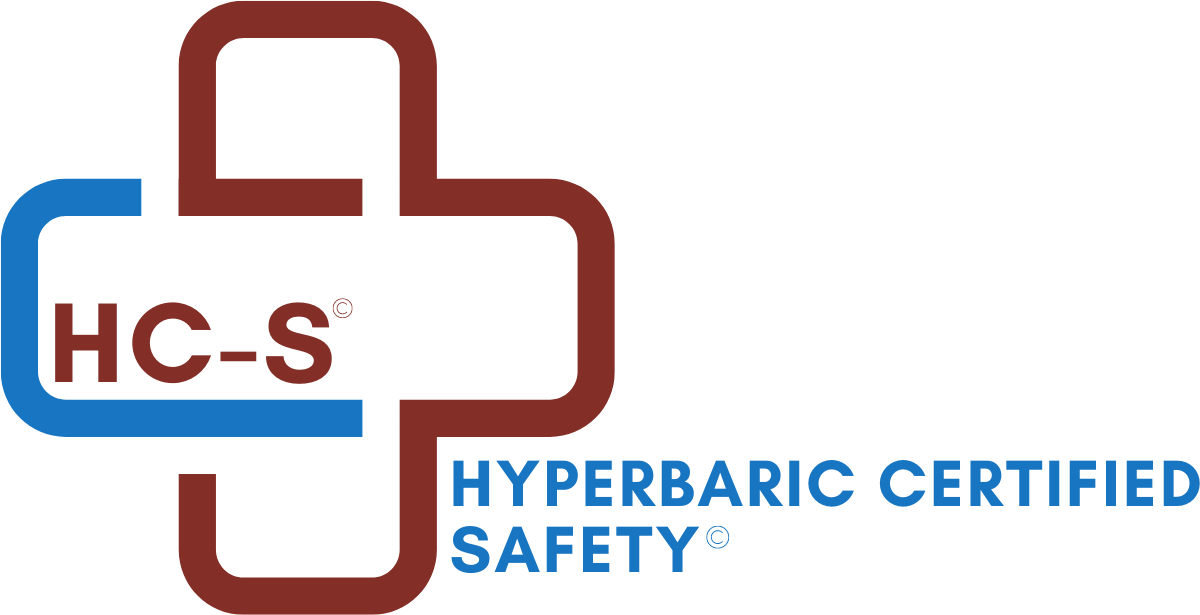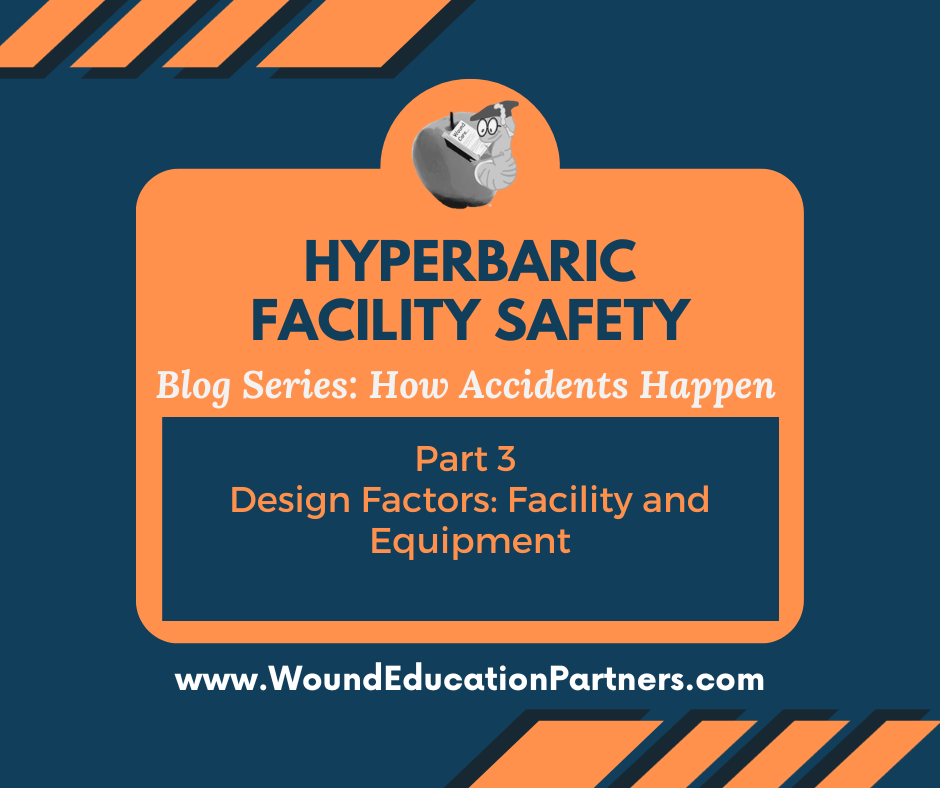Rx Pad
Part 3: Personnel & Management as Contributing Factors in Hyperbaric Facility Accidents (continued)
In this third and final installment of How Accidents Happen we continue looking at personnel & management as contributing factors in hyperbaric facility accidents.
Design Factors: Facility and Equipment
The second largest group of factors that may contribute to an accident are design factors. These factors can be like bandits waiting for the right set of circumstances to come along. These factors are typically ones that promote operational mistakes or increase the potential severity of simple miscues such as a fall. The factors discussed in this sec- tion, as in the previous section, are not all-inclusive. Operational personnel need to be constantly on the lookout for conditions that appear capable of promoting an accident.
Controls/Indicators that Lie or Confuse
One group of “equipment factors” that are commonly found in accident reconstruction is controls or indicators that encourage an operator to make an error. These factors can appear in an endless variety of forms. Designers, operators, and safety directors should constantly be on the lookout for them and fix them when found. Too often, the presence of such factors is known, but personnel make the decision, either deliberately or by default due to inaction, to make allowances for them and proceed. Some of the more common forms of this factor are described below.
-
Switchable chamber pressure (depth) gauges: The idea of a highly accurate master gauge that could be switched to any one of several chambers in a large saturation diving system was popular at one time. However, the presence of a switchable gauge carries with it the need for clear and unmistakable indication of the chamber to which it is connected.
-
Multiple or inconsistent gauge scales: Many gauges, especially pressure gauges, come with dual scales. Scales of pounds per square inch (PSIG) and kilo-pascal (kPa) are a common pairing. Often the scales are different colors and one is clearly “dominant” over the other from a visual viewpoint. When such gauges are used, care should be taken to make sure that the scales in all gauges in the facility have the same general arrangement. Operators quickly get used to reading the scale that they prefer. If suddenly a gauge comes along that has the scales reversed, operators are highly likely to read the scale in the place on the gauge where they are accustomed to looking or in the color they are used to reading. Some years ago, a commercial airliner ran out of fuel at 37,000 feet over Canada because the fuel level in the tanks had been measured in liters and reported in gallons.
-
Multiple devices on chamber pressure (depth) gauges: Chamber pressure gauges are highly accurate devices that are often at the end of a long, small, diameter tube. Under normal circumstances that arrangement works fine. However, if a leak develops near the gauge end of the line, the resulting flow through the line is often sufficient to generate a pressure drop in the line large enough to cause seriously erroneous gauge readings. ASME PVHO-1-2016, section 4-9.4.32 requires that chamber pressure gauge lines have a diameter of not less than 0.12 inches (3 mm) and that the lines to chamber pressure gauges are not shared by other devices.
Alarms with High Rate of Nuisance Alarms
Alarms that go off frequently without due cause are annoying. If the situation persists, the usual result is that the alarms are soon disabled and the supervision capability they were intended to provide is lost. To be effective, alarms must be set so that they have real meaning yet leave enough margin so that they do not require instantaneous or pre- cipitous action. A common method of implementing this is to have two levels of alarm condition. The first one is a warning level requiring assessment of the situation but not necessarily corrective action. The second level, reached only after passing the first level, is an action level requiring some form of response by the facility operators.
Absence of Appropriate Safety Devices
This is a very good way to encourage an accident. Safety devices that are sometimes overlooked in hyperbaric facilities include the following:
-
Appropriately sized relief valves downstream from pressure reducing regula- tors. Too often relief valves are sized on the basis of, “If the line size is one inch, then a one-inch relief valve should be okay.” Instead, the relief valves located downstream of pressure-reducing regulators need to be sized for a full-open fai- lure of the upstream regulator at maximum possible supply pressure. In many circumstances, this can result in a relief valve that is several sizes larger than the nominal size on the line it is installed on. Positive means of avoiding inadvertent mixing of outlet gases or the back-feeding of one supply gas into another in cir- cuits where one outlet can be switched between multiple inlets should be taken.
-
Reverse pressure relief on doors that can be dogged closed.
-
Relief valves between every pair of stop valves on lines that may contain lique- fied gases. Any segment of a piping systems where a cryogenic liquid can possibly become trapped must have a relief valve
“Temporary” Hookups that Never Get Cleaned Up
While this is just good housekeeping, in older facilities, the number of “dead” lines can be surprising. Such lines lead to clutter and confusion, especially if they no longer appear on facility drawings, and should be removed. Unneeded equipment still in place was a contributing factor to the accident discussed in the case history at the end of this chapter.
Room Pressure Relief and the Effects of Gas Discharges
The need for attention to the possibility of overpressurizing or underpressurizing the room housing the chamber (room barotrauma) is discussed in Chapter 4.2: Piping Systems.
However, the effects on room gas composition of gas discharges from the facility also need to be considered. A typical portable liquid oxygen cylinder contains the equivalent of 4,500 standard cubic feet (scf) oxygen. That much oxygen released into a chamber room that is 20 ft wide by 40 ft long by 10 ft high (8,000 cubic ft total volume) would raise the oxygen fraction in the room to over 50% by volume, a very dangerous level. Such a discharge is unlikely when the facility is in operation because the noise would be noticed. However, an improperly tightened connection can easily discharge the entire contents of a liquid cylinder over a weekend or overnight. This is why oxygen cylinders are required by NFPA 99, Chapter 5 to be stored in vented rooms. NFPA 99, Chapter 14 (section 14.2.1.6)1 requires the storage and handling of nonflammable gases in a hyperbaric facility to conform to NFPA 99, Chapter 5 and Chapter 11 rules. This requirement is located in the Administration and Maintenance section of NFPA 99, Chapter 14.
Similar care needs to be taken any time inert gases, such as nitrogen used for dilution purposes, are introduced into a hyperbaric facility. Here the risk is not one of fire but rather one of risk to personnel if significant quantities of the inert gas are accidentally released. For example, if nitrogen purging is employed in a chamber, consideration must be given to the effect on the oxygen level in the chamber should a purge line be left running overnight in an almost closed chamber.
Patient Handling Provisions
In many facilities, the biggest safety risk is not fire, high oxygen, structural failure, or any of the other well-known hazards of hyperbaric operations. It is the risk of back injuries to personnel from handling patients. A related risk is the risk of losing control of a patient. It is easily recognized that asking two 90-pound nurses to move a comatose 300-pound patient into a 60-inch diameter chamber where no one can stand erect is not a good idea unless a very effective patient handling system in place. The nature of patient han- dling operations is such that similar, although not so extreme, conditions can easily occur in many facilities given the right set of circumstances. Facility safety directors must be aware of the capabilities and limitations of their facility in this regard and be continually alert to avoid situations that place patients and/or staff at risk. Necessary guidelines may need to be established ahead of time in order to prevent personnel from being placed in situations with a high degree of risk.
Personnel Hazards
- Head-crackers: Fire suppression nozzles protruding from the ceiling in a small chamber can make business for the local emergency room physician. So can a variety of other devices. The author at one time observed a chamber fire sup- pression header where the nozzles had been turned to an ineffective orientation in order to reduce the risk to the attendants’ heads. This situation was quickly corrected and the “head-cracker” hazard eliminated by making an acrylic shroud for the fire suppression header with appropriately placed holes for the nozzles. Head-cracker hazards are best eliminated at the design stage. However, if encountered in service, most such hazards can be mitigated by properly designed covers or guards.
-
Trip hazards: Trip hazards are, as their name implies, things that can easily catch feet. Door sills are unavoidable in many chambers. However, uneven floors and other protrusions that can be eliminated should be corrected. If a trip hazard cannot be eliminated, it should be marked.
-
Impalement hazards: Impalement hazards are items that can do bodily injury if someone should fall on them. Such hazards are not common, but do occur. If found, corrective action should be taken.
-
Grab hazards: Any item in a chamber that is placed such that a person who has lost his balance could reach for it to steady himself should be strong enough to not pull loose under the load.
Excessively Noisy Environments
Excessive noise interferes with communications and contributes to fatigue. The hard, smooth surfaces typical of chamber interiors tend to make them highly reverberant enclosures. This can amplify any noise that is generated inside the chamber. The principal noise sources in most chambers are the pressurization and exhaust lines and the fans used for air conditioning. Effective mufflers are necessary on both supply and exhaust lines. Air conditioning fans and related equipment also need to be selected for minimum noise generation.
Maintenance Impediments
Maintenance is important. However, medical hyperbaric facilities are also expected to operate nearly continuously. Maintenance that cannot be done easily tends to be main- tenance that doesn’t get done. Some typical examples follow.
- Fire systems that cannot be tested without deluging the chamber: It is recommended that fire suppression systems (FSS) be exercised at full capacity at least once every six months. NFPA 99, (section 14.3.4.3.5)1 now requires such a test at least semian- nually. It has been shown repeatedly that FSS that are not exercised regularly may not work when called upon. However, if exercising the FSS means pouring large quantities of dirty, rusty water into a clean medical chamber that is difficult to restore to a clean state, it is not difficult to understand why operating person- nel will try to find any reason possible to avoid such an event. NFPA 99 (section 14.3.4.3.5.2)1 specifically permits a deluge bypass test in lieu of wetted test if bypass system is installed. Bypass deluge test allows the maintenance test water to be discharged outside the chamber and therefore less time consuming. The use of such bypass provisions is encouraged. Another alternative for smaller chambers is the attachment of a hose leading out of the chamber to each nozzle or nozzle base.
- Absence of access: Filters and other devices requiring periodic maintenance must be accessible with reasonable effort. Effective service access for compressors may require both personnel access and access for necessary lifting devices. Consoles need to be designed and positioned such that maintenance access to internal items is provided.
- Redundancy and downtime limitations: All compressors require periodic main- tenance and sometimes emergency repairs. The same is true of many other components. However, downtime is expensive. Maintenance and repair func- tions are more easily and reliably carried out if the facility has been designed with sufficient redundancy so that necessary maintenance can be done without taking the facility out of service.
Controls Subject to Inadvertent Activation
Controls subject to accidental operation can easily contribute to an accident situation. If such controls are found, appropriate corrective action should be taken. Typical examples follow.
- Fire suppression deluge controls: Toggle style and push-button controls should be fitted with protective covers.
- Controls for compressors and rotating machinery: Start-stop controls should be placed where they are not subject to accidental operation. Local lockout switches at each machine are required by most occupational safety organiza- tions so that personnel performing maintenance can be assured that the device cannot be started from remotely located control stations.
Excerpted with permission from the publisher. Source Reference Hyperbaric Facility Safety: A Practical Guide, Second Edition
Learn More About Hyperbaric Facility Safety with our 16-hour CEU Course! Find more details here.
When you subscribe to the blog, we will send you an e-mail when there are new updates on the site so you wouldn't miss them.



Comments